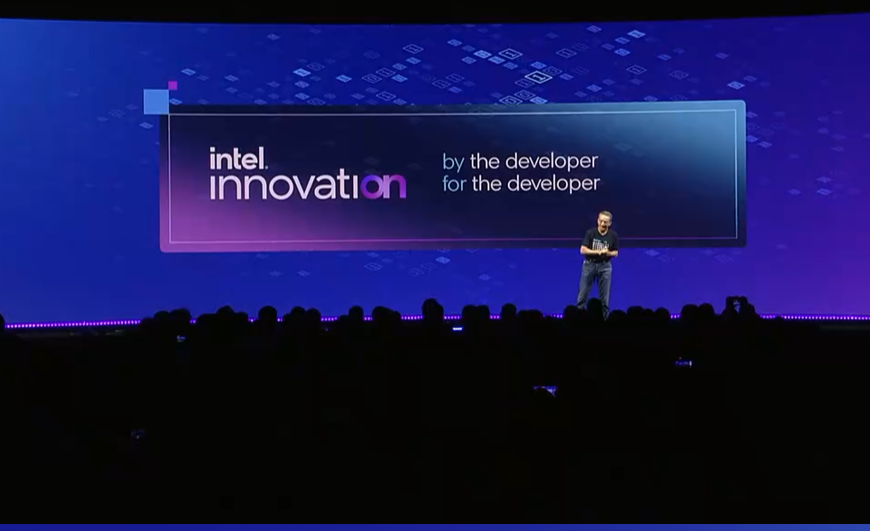Intel’s engineering roots saw a revival at this week’s Innovation, with attendees recalling the show’s resemblance to Intel Developer Forum, the company’s annual developer gala last held in 2016.
The chipmaker cut the number of technical sessions over the last few years of IDF, and instead focused on the company’s coolness, with drones, robots and gadgetry dotting the show floors. Developers felt lost in the consumer-focused Intel, which lost its engineering edge with poor product decisions and manufacturing delays.
Intel is a very different company today. The chipmaker’s focus at Innovation is on software and hardware engineering, and to appease technologists disillusioned with the company’s loss of focus over the last decade. Rivals like AMD, Qualcomm, Arm and Apple became more competitive while Intel’s leadership was asleep.
Intel is now placing all its bets on manufacturing, with four technological advances in five years, which is unprecedented in chip manufacturing. Intel previously advanced manufacturing every two years.
 But CEO Pat Gelsinger, who took over as the company’s leader in February 2021, set the aggressive roadmap to take back the manufacturing leadership it ceded to Taiwan Semiconductor Manufacturing Co. over the last decade.
But CEO Pat Gelsinger, who took over as the company’s leader in February 2021, set the aggressive roadmap to take back the manufacturing leadership it ceded to Taiwan Semiconductor Manufacturing Co. over the last decade.
Unlike the past of making chips for itself, Intel now wants to become a chipmaker for the world. Intel’s IDM 2.0 strategy revolves around becoming a “systems foundry” with factories packaging full systems in chips by cramming together multiple components in a single package. Intel will also overlay software and other components to deliver full soups-to-nuts products.
Intel is also providing customers more flexibility on how to compose chips. The chipmaker is partnering with TSMC and Samsung, the other top chip-manufacturing companies, on interfaces and packaging technologies. The open standards on chip design and connectivity interfaces will allow customers to outsource assembly and testing.
TSMC and Samsung share a common vision of standardization on chiplets with UCIe and interconnects, but Intel hopes software will attract companies to its foundries.
“That’s the path that we’re on. And we believe that becomes a differentiator for us because of our software assets driving the standards, and the rich set of ecosystem technologies that we bring to the table,” Gelsinger said
Intel is spending billions to establish new factories in Ohio, Europe and other countries. The company is in the process of acquiring Tower Semiconductor – which makes low-end chips that were not easily available during the recent chip shortages – to offer a full suite of chips beyond its cutting-edge PC, server and mobility chips.
But there have been many bumps along the road. Intel has committed to invest in excess of $40 billion in capital – which could ultimately exceed $100 billion – in new factories established in places like Ohio and Magdeburg, Germany. But with a recession on the horizon, Intel has talked about cost-cutting measures and other plans to scale back investments.
“Near term business requirements are causing us to be more austere in our investments, we have to be very, very thoughtful about where we put our operational dollars,” Gelsinger said.
It takes Intel about 12 to 14 quarters to build a fab, and the company doesn’t want to make decisions on short-term opportunities.
“Yes, we need to manage our cash carefully, but we are investing for the long term. That is our strategy for building the process technologies for unquestioned leadership, five nodes and four years. We’re building the capacity to ramp those technologies,” Gelsinger said.
More recently, Intel scored a win by lobbying the U.S. government to pass the U.S. CHIPS Act, which will open up subsidies to the tune of billions for the chipmaker to build its Ohio factory. But the legislation also came with its challenges: it has guardrails that would ban Intel from making investments to expand chip manufacturing capacity in countries such as China.
Other challenges have emerged: export controls have limited the types of semiconductors that chipmakers can ship to China and other countries considered rivals to the U.S.
Gelsinger said China was an important market for Intel in response to a question from HPCwire.
He said Intel has distributed its foundry operations so as to adjust to the geopolitical shifts around localizing chip manufacturing and securing domestic semiconductor supply chains.
The company is taking a multi-source approach and diversifying its risk across countries with global expansion. Gelsinger said the company will adjust the realities on supplying chips to countries based on the local policies and restrictions.
Intel is ensuring they have multiple sources at least for everybody, and be geographically distributed for materials and other elements such as lithography tools and deposition tools, said Dylan Patel, founder of SemiAnalysis, a semiconductor research and consulting firm.
“I think his point was like ‘our technology decisions are not being impacted. Our fab buildouts are not being impacted by regulatory or financial short-term things.’ But then there’s the high-volume manufacturing work, which probably they have to deal with,” Patel said.
But things can change quickly, and it’s hard to predict what the political situation may be a few years from now, Patel said.
“It’s maybe not the development of the technology, but the rollout of it that could be different. Nvidia couldn’t have planned six months ago that its chips were banned from [shipping to] China, right?” Patel said.
A poster for Intel Foundry Services at a booth on the show floor advertised the manufacturing plants as having a “geo-diverse manufacturing footprint” based on “Western R&D” with “government engagement” at the supply chain level.
That was more a preview of how IFS will operate: the company will try to comply with regulations at each level of chip design, from EDA tools to design chips to materials and technologies inside chips.
Countries like China and the U.S. have weaponized semiconductors by taking larger interest in chip assets like EDA tools and shaping policy around it.
“[Gelsinger’s] trying to avoid single choke points, where one source controls too much of the supply chain,” said Kevin Krewell, an analyst at Tirias Research.
Intel held multiple sessions over the two days of the show outlining IFS to attendees. The top IFS component is advancing scaling and performance of chips with advances in transistors, electricals and lithography technologies. The second component is interfaces for chiplets like UCIe, and third is 2.5D and 3D packaging technologies to pack more transistors into chips.
“Advanced packaging is one of the key driving forces behind the computer industry growth and our goal of 1 trillion transistors by 2030,” said Gary Martz, senior director for Intel Foundry Services, RISC-V enablement during one session.
Software is the final layer that loops it all together.
“[As] we repartition hardware from SOCs into separate chiplets, we must also evolve our software solutions and tools so that we can maximize reuse,” Martz said.
Intel is also looking to partner with smaller chipmakers that want to use their foundries, said Bob Brennan, vice president and general manager for Intel Foundry Services’ customer solutions engineering, answering a question from HPCwire during the breakout session.
An engagement with a smaller chipmaker could revolve around small volumes, or releasing test chips. In these partnerships, Intel is gambling that some small-volume chips will become big hits, which would bring more business to the factories.
Intel is opening up its Intel 16, Intel 3 and the most advanced Intel 18A processes – which is expected in the 2024-2025 timeframe – to external customers. Gelsinger said Intel expects the first test chip on the 18A process before the end of the year.





























































